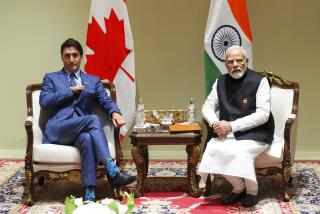Canada Bests U.S. on Land Mines
- Share via
OTTAWA — When Canadian Foreign Affairs Minister Lloyd Axworthy announced in October that Canada would spearhead an effort for an international treaty banning land mines by the end of 1997, U.S. State Department officials privately wrote the move off as naive posturing. Washington estimated that just 40 to 50 countries--none military powers--would ever sign such a pact.
Even here in the Canadian capital, the forecast was pessimistic. When the Foreign Affairs Ministry’s arms control division staff, who had persuaded Axworthy that the time was ripe for his risky initiative, began an office pool on the number of countries that would sign, division director Jill Sinclair bet on 67--a prediction, she conceded, “far too low for somebody who was supposed to be out there leading the charge for this.”
But on Monday, officials from more than 100 countries, including Britain, France, Germany, South Africa and Japan, will gather in Oslo to negotiate the final language of the treaty banning the use, production and sale of antipersonnel land mines, and almost all are expected to show up in Ottawa in December for the formal signing.
Also among the nations in Oslo will be the United States, which reversed course two weeks ago and scrambled to join the Canadian effort.
These are heady times for Canada, a country that usually labors in the shadow of its powerful neighbor. Ottawa suddenly is hogging the diplomatic spotlight, and Axworthy has been nominated for the Nobel Peace Prize. In a moment of unguarded exuberance, one Canadian official stationed in the United States joked about “the Clinton administration worshiping at the altar of Canadian diplomacy.”
How did Canada, a third-tier military power at odds with America, engineer a major arms-control agreement? The answer: a blending of modern media techniques with old-fashioned diplomatic arm twisting, shrewd timing and good luck.
The Canadians joined forces with an international lobby of private groups dedicated to eliminating mines. These humanitarian relief agencies, church groups, veterans organizations and peace activists brought their own badgering style to the treaty process, often to the consternation of diplomats.
Government officials and military officers at international conferences were confronted by amputees crippled by mines and brought to meetings by advocacy groups. In lobbying materials and media releases, backers of the ban featured images of maimed women and children, a reminder that the 25,000 victims of mines annually are overwhelmingly civilians. One poster drawn for a conference in Sydney, Australia, showed a prosthetic leg propped against a wall next to a teddy bear. Another displayed a giant photograph of a child with one eye lost to shrapnel.
Canadian officials acknowledge that many diplomats regarded these tactics as gimmicky and superficial, but the strategy succeeded in framing the public debate in humanitarian rather than military terms.
“This is an idea that captivated the world at the individual level,” acknowledged one U.S. official. “It’s a credit to the Canadians and the . . . hundreds of groups who put this on the public radar screen. It’s a grass-roots, up-from-the-bottom movement to ban a certain type of weapon.”
The Canadian government approached the task with a sense of mission usually reserved for war. Although principal responsibility for rounding up support for the treaty fell to just seven employees in the Foreign Affairs Ministry’s arms control office, the government enlisted every overseas embassy and consulate in the battle.
Every Canadian official headed on a foreign mission was given a laminated, pocket-sized list of instructions on how to push the treaty. The ban was atop the agenda of every meeting between Canadian and foreign officials, regardless of other topics. The ministry produced a five-minute video on the proposal, dubbed into more than half a dozen languages and distributed to hundreds of countries for broadcast.
On return here from overseas, staffers went to a world map at the Foreign Affairs Ministry and shaded in countries that had signed on to the ban. As that number grew, the Canadians found themselves in an odd, sometimes uncomfortable competition with the United States.
Although the Clinton administration long has favored a land-mine ban, it objected to the Canadian proposal. The Pentagon did not want to give up its mines until every other country did, and it didn’t want to give them up in South Korea, where they are part of the defenses against the North.
Axworthy’s idea was to get as many nations as possible to agree to a complete ban in hopes of isolating holdouts as pariahs. “What we are seeking is not a traditional arms-control treaty but the establishment of a new international humanitarian norm against these weapons,” Axworthy said in March. “It will do what the world has already done to dumdum bullets, poison gas and blinding laser weapons.”
The U.S. response was to propose a ban negotiated at the U.N. Conference on Disarmament in Geneva, a notoriously contentious forum known to drag out negotiations for decades.
Both the U.S. and Canada publicly described their proposals as “complementary,” but behind the scenes, each lobbied furiously for its plan and against the other.
Meanwhile, the Canadians received unexpected endorsements. In January, Britain’s Princess Diana paid a highly publicized visit to Angola to meet with mine victims and called for an immediate moratorium on the weapons. Then, spring elections in Britain and France brought new parties to power that shifted their support from the American to the Canadian approach.
“I don’t want to overestimate Diana’s contribution, but she brought a level of media hype and public attention to the issue that never existed before, and it brought pressure on governments,” Sinclair said.
As months passed, more and more countries joined Canada. Meanwhile, the Americans could not even get their ban on the formal agenda in Geneva.
Andrew Natsias, a former Bush administration official who now monitors the land mine issue for the relief organization World Vision, observed: “It was sort of an embarrassment to the United States for our neighbor to be out leading this and for them to be portrayed in the international media as the good guys and us as the bad guys.”
When the Americans finally came aboard in mid-August, the event was regarded in Ottawa as almost anticlimactic.
The administration is not yet committed to signing the treaty in Ottawa. U.S. negotiators in Oslo will press for a delay in the treaty’s enforcement in South Korea and for other textual adjustments. U.S. officials insist they will walk away if they don’t get the changes.
But Canadian officials already are planning to launch a follow-up campaign after the treaty is signed. It will focus on raising money for mine removal and victim aid, as well as pressuring those nations that have not signed the treaty.
More to Read
Sign up for Essential California
The most important California stories and recommendations in your inbox every morning.
You may occasionally receive promotional content from the Los Angeles Times.










